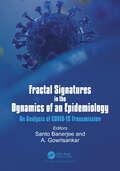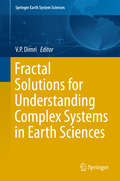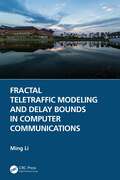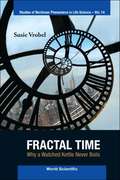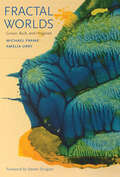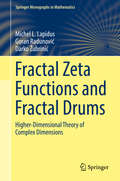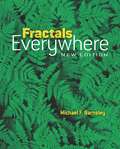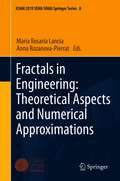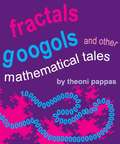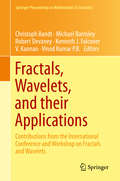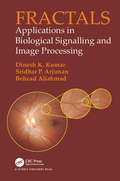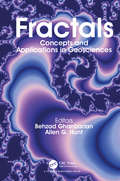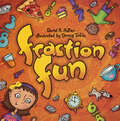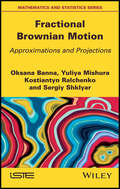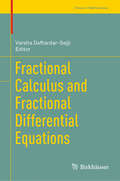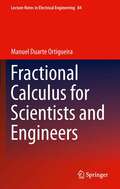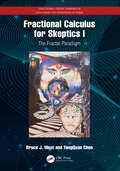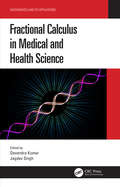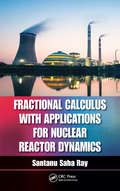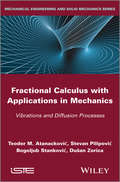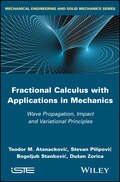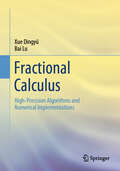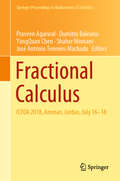- Table View
- List View
Fractal Signatures in the Dynamics of an Epidemiology: An Analysis of COVID-19 Transmission
by Santo Banerjee A. GowrisankarThe recent Covid-19 pandemic threw the world into complete chaos with its rapid and devastating spread. Scientists are still trying to obtain a better understanding of the patterns of COVID-19 and trying to get a deeper understanding of mutant strains and their pathogenicity by performing genomic sequences of more samples. Fractal-based analysis provides its unique forecasting policy to reduce the spread of COVID-19, and in general, of any outbreaks. The book presents fractal and multifractal models of COVID-19 and reviews the impact of the pandemic including epidemiology, genome organization, transmission cycle, and control strategies based on mathematical models towards developing an immune intervention. Also, it covers non-clinical aspects such as economic development with graphical illustrations, meeting the needs of onlookers outside the sector who desire additional information on the epidemic. The fractal signatures describe the fractal textures in the patterns of Corona virus. Studies on the epidemiology of Covid-19 in relation with the fractals and fractal functions serve to exhibit its irregular chaotic nature. Moreover, the book with its wide coverage on the Hurst exponent analysis and the fractal dimension estimation, greatly aids in measuring the epidemiology.
Fractal Solutions for Understanding Complex Systems in Earth Sciences
by V. P. DimriThis book deals with fractals in understanding problems encountered in earth science, and their solutions. It starts with an analysis of two classes of methods (homogeneous fractals random models, and homogeneous source distributions or "one point" distributions) widely diffused in the geophysical community, especially for studying potential fields and their related source distributions. Subsequently, the use of fractals in potential fields is described by scaling spectral methods for estimation of curie depth. The book also presents an update of the use of the fractal concepts in geological understanding of faults and their significance in geological modelling of hydrocarbon reservoirs. Geophysical well log data provide a unique description of the subsurface lithology; here, the Detrended Fluctuation Analysis technique is presented in case studies located off the west-coast of India. Another important topic is the fractal model of continuum percolation which quantitatively reproduce the flow path geometry by applying the Poiseuille's equation. The pattern of fracture heterogeneity in reservoir scale of natural geological formations can be viewed as spatially distributed self-similar tree structures; here, the authors present simple analytical models based on the medium structural characteristics to explain the flow in natural fractures. The Fractal Differential Adjacent Segregation (F-DAS) is an unconventional approach for fractal dimension estimation using a box count method. The present analysis provides a better understanding of variability of the system (adsorbents - adsorbate interactions). Towards the end of book, the authors discuss multi-fractal scaling properties of seismograms in order to quantify the complexity associated with high-frequency seismic signals. Finally, the book presents a review on fractal methods applied to fire point processes and satellite time-continuous signals that are sensitive to fire occurrences.
Fractal Teletraffic Modeling and Delay Bounds in Computer Communications
by Ming LiBy deploying time series analysis, Fourier transform, functional analysis, min-plus convolution, and fractional order systems and noise, this book proposes fractal traffic modeling and computations of delay bounds, aiming to improve the quality of service in computer communication networks. As opposed to traditional studies of teletraffic delay bounds, the author proposes a novel fractional noise, the generalized fractional Gaussian noise (gfGn) approach, and introduces a new fractional noise, generalized Cauchy (GC) process for traffic modeling. Researchers and graduates in computer science, applied statistics, and applied mathematics will find this book beneficial. Ming Li, PhD, is a professor at Ocean College, Zhejiang University, and the East China Normal University. He has been an active contributor for many years to the fields of computer communications, applied mathematics and statistics, particularly network traffic modeling, fractal time series, and fractional oscillations. He has authored more than 200 articles and 5 monographs on the subjects. He was identified as the Most Cited Chinese Researcher by Elsevier in 2014–2020. Professor Li was recognized as a top 100,000 scholar in all fields in 2019–2020 and a top 2% scholar in the field of Numerical and Computational Mathematics in 2021 by Prof. John P. A. Ioannidis, Stanford University.
Fractal Time: Why a Watched Kettle Never Boils (Studies of Nonlinear Phenomena in Life Science, Volume 14)
by Susie VrobelThis book provides an interdisciplinary introduction to the notion of fractal time, starting from scratch with a philosophical and perceptual puzzle.
Fractal Worlds: Grown, Built, and Imagined
by Michael Frame Amelia UrryFractal geometry is a uniquely fascinating area of mathematics, exhibited in a range of shapes that exist in the natural world, from a simple broccoli floret to a majestic mountain range. In this essential primer, mathematician Michael Frame—a close collaborator with Benoit Mandelbrot, the founder of fractal geometry—and poet Amelia Urry explore the amazing world of fractals as they appear in nature, art, medicine, and technology. Frame and Urry offer new insights into such familiar topics as measuring fractal complexity by dimension and the life and work of Mandelbrot. In addition, they delve into less-known areas: fractals with memory, the Mandelbrot set in four dimensions, fractals in literature, and more. An inviting introduction to an enthralling subject, this comprehensive volume is ideal for learning and teaching.
Fractal Zeta Functions and Fractal Drums: Higher-Dimensional Theory of Complex Dimensions (Springer Monographs in Mathematics)
by Michel L. Lapidus Goran Radunović Darko ŽubrinićThis monograph gives a state-of-the-art and accessible treatment of a new general higher-dimensional theory of complex dimensions, valid for arbitrary bounded subsets of Euclidean spaces, as well as for their natural generalization, relative fractal drums. It provides a significant extension of the existing theory of zeta functions for fractal strings to fractal sets and arbitrary bounded sets in Euclidean spaces of any dimension. Two new classes of fractal zeta functions are introduced, namely, the distance and tube zeta functions of bounded sets, and their key properties are investigated. The theory is developed step-by-step at a slow pace, and every step is well motivated by numerous examples, historical remarks and comments, relating the objects under investigation to other concepts. Special emphasis is placed on the study of complex dimensions of bounded sets and their connections with the notions of Minkowski content and Minkowski measurability, as well as on fractal tube formulas. It is shown for the first time that essential singularities of fractal zeta functions can naturally emerge for various classes of fractal sets and have a significant geometric effect. The theory developed in this book leads naturally to a new definition of fractality, expressed in terms of the existence of underlying geometric oscillations or, equivalently, in terms of the existence of nonreal complex dimensions. The connections to previous extensive work of the first author and his collaborators on geometric zeta functions of fractal strings are clearly explained. Many concepts are discussed for the first time, making the book a rich source of new thoughts and ideas to be developed further. The book contains a large number of open problems and describes many possible directions for further research. The beginning chapters may be used as a part of a course on fractal geometry. The primary readership is aimed at graduate students and researchers working in Fractal Geometry and other related fields, such as Complex Analysis, Dynamical Systems, Geometric Measure Theory, Harmonic Analysis, Mathematical Physics, Analytic Number Theory and the Spectral Theory of Elliptic Differential Operators. The book should be accessible to nonexperts and newcomers to the field.
Fractals Everywhere: New Edition
by Michael F. Barnsley"Difficult concepts are introduced in a clear fashion with excellent diagrams and graphs." — Alan E. Wessel, Santa Clara University"The style of writing is technically excellent, informative, and entertaining." — Robert McCartyThis new edition of a highly successful text constitutes one of the most influential books on fractal geometry. An exploration of the tools, methods, and theory of deterministic geometry, the treatment focuses on how fractal geometry can be used to model real objects in the physical world. Two sixteen-page full-color inserts contain fractal images, and a bonus CD of an IFS Generator provides an excellent software tool for designing iterated function systems codes and fractal images. Suitable for undergraduates and graduate students of many backgrounds, the treatment starts with an introduction to basic topological ideas. Subsequent chapters examine transformations on metric spaces, dynamics on fractals, fractal dimension and interpolation, Julia sets, and parameter spaces. A final chapter introduces measures on fractals and measures in general. Problems and tools emphasize fractal applications, and an answers section contains solutions and hints.
Fractals and Multifractals in Ecology and Aquatic Science
by Laurent SeurontEcologists sometimes have a less-than-rigorous background in quantitative methods, yet research within this broad field is becoming increasingly mathematical. Written in a step-by-step fashion, Fractals and Multifractals in Ecology and Aquatic Science provides scientists with a basic understanding of fractals and multifractals and the techniques fo
Fractals in Engineering: Theoretical Aspects and Numerical Approximations (SEMA SIMAI Springer Series #8)
by Maria Rosaria Lancia Anna Rozanova-PierratFractal structures or geometries currently play a key role in all models for natural and industrial processes that exhibit the formation of rough surfaces and interfaces. Computer simulations, analytical theories and experiments have led to significant advances in modeling these phenomena across wild media. Many problems coming from engineering, physics or biology are characterized by both the presence of different temporal and spatial scales and the presence of contacts among different components through (irregular) interfaces that often connect media with different characteristics. This work is devoted to collecting new results on fractal applications in engineering from both theoretical and numerical perspectives. The book is addressed to researchers in the field.
Fractals, Googols, and Other Mathematical Tales
by Theoni PappasA treasure trove of stories that make mathematical ideas come to life. Explores math concepts and topics such as real numbers, exponents, dimensions, the golden rectangle in both serious and humorous ways. Stories such as the parable of p, the number line that fell apart, Leonhard the magic turtle and many others offer an amusing and entertaining way to explore and share mathematical ideas regardless of age or background. The reference section following each story is designed as enrichment information for the concepts presented in each story.
Fractals, Wavelets, and their Applications
by Christoph Bandt Michael Barnsley Robert Devaney Kenneth J. Falconer V. Kannan Vinod Kumar P.B.Fractals and wavelets are emerging areas of mathematics with many common factors which can be used to develop new technologies. This volume contains the selected contributions from the lectures and plenary and invited talks given at the International Workshop and Conference on Fractals and Wavelets held at Rajagiri School of Engineering and Technology, India from November 9-12, 2013. Written by experts, the contributions hope to inspire and motivate researchers working in this area. They provide more insight into the areas of fractals, self similarity, iterated function systems, wavelets and the applications of both fractals and wavelets. This volume will be useful for the beginners as well as experts in the fields of fractals and wavelets.
Fractals: Applications in Biological Signalling and Image Processing
by Dinesh Kumar Sridhar P. Arjunan Behzad AliahmadThe book provides an insight into the advantages and limitations of the use of fractals in biomedical data. It begins with a brief introduction to the concept of fractals and other associated measures and describes applications for biomedical signals and images. Properties of biological data in relations to fractals and entropy, and the association with health and ageing are also covered. The book provides a detailed description of new techniques on physiological signals and images based on the fractal and chaos theory. The aim of this book is to serve as a comprehensive guide for researchers and readers interested in biomedical signal and image processing and feature extraction for disease risk analyses and rehabilitation applications. While it provides the mathematical rigor for those readers interested in such details, it also describes the topic intuitively such that it is suitable for audience who are interested in applying the methods to healthcare and clinical applications. The book is the outcome of years of research by the authors and is comprehensive and includes other reported outcomes.
Fractals: Concepts and Applications in Geosciences
by Behzad Ghanbarian Allen G. HuntThis book provides theoretical concepts and applications of fractals and multifractals to a broad range of audiences from various scientific communities, such as petroleum, chemical, civil and environmental engineering, atmospheric research, and hydrology. In the first chapter, we introduce fractals and multifractals from physics and math viewpoints. We then discuss theory and practical applications in detail. In what follows, in chapter 2, fragmentation process is modeled using fractals. Fragmentation is the breaking of aggregates into smaller pieces or fragments, a typical phenomenon in nature. In chapter 3, the advantages and disadvantages of two- and three-phase fractal models are discussed in detail. These two kinds of approach have been widely applied in the literature to model different characteristics of natural phenomena. In chapter 4, two- and three-phase fractal techniques are used to develop capillary pressure curve models, which characterize pore-size distribution of porous media. Percolation theory provides a theoretical framework to model flow and transport in disordered networks and systems. Therefore, following chapter 4, in chapter 5 the fractal basis of percolation theory and its applications in surface and subsurface hydrology are discussed. In chapter 6, fracture networks are shown to be modeled using fractal approaches. Chapter 7 provides different applications of fractals and multifractals to petrophysics and relevant area in petroleum engineering. In chapter 8, we introduce the practical advantages of fractals and multifractals in geostatistics at large scales, which have broad applications in stochastic hydrology and hydrogeology. Multifractals have been also widely applied to model atmospheric characteristics, such as precipitation, temperature, and cloud shape. In chapter 9, these kinds of properties are addressed using multifractals. At watershed scales, river networks have been shown to follow fractal behavior. Therefore, the applications of fractals are addressed in chapter 10. Time series analysis has been under investigations for several decades in physics, hydrology, atmospheric research, civil engineering, and water resources. In chapter 11, we therefore, provide fractal, multifractal, multifractal detrended fluctuation analyses, which can be used to study temporal characterization of a phenomenon, such as flow discharge at a specific location of a river. Chapter 12 addresses signals and again time series using a novel fractal Fourier analysis. In chapter 13, we discuss constructal theory, which has a perspective opposite to fractal theories, and is based on optimizationof diffusive exchange. In the case of river drainages, for example, the constructal approach begins at the divide and generates headwater streams first, rather than starting from the fundamental drainage pattern.
Fraction Fun
by David A. AdlerWould you rather eat 1/4 of a pizza or 1/8 of a pizza? Find 3/4 of a dollar or 1/10 of a dollar? Confused? You don't have to be! Fractions are made easy in this simple and hands-on math concept book. You'll learn what the top and bottom numbers are called, and what they mean. You will also find out how to recognize and compare different fractions. Just follow the clear instructions and you will learn the most important thing of all -- that fractions can be fun!
Fractional Brownian Motion: Approximations and Projections (Lecture Notes in Mathematics #1929)
by Yuliya Mishura Kostiantyn Ralchenko Oksana Banna Sergiy ShklyarThis monograph studies the relationships between fractional Brownian motion (fBm) and other processes of more simple form. In particular, this book solves the problem of the projection of fBm onto the space of Gaussian martingales that can be represented as Wiener integrals with respect to a Wiener process. It is proved that there exists a unique martingale closest to fBm in the uniform integral norm. Numerical results concerning the approximation problem are given. The upper bounds of distances from fBm to the different subspaces of Gaussian martingales are evaluated and the numerical calculations are involved. The approximations of fBm by a uniformly convergent series of Lebesgue integrals, semimartingales and absolutely continuous processes are presented. As auxiliary but interesting results, the bounds from below and from above for the coefficient appearing in the representation of fBm via the Wiener process are established and some new inequalities for Gamma functions, and even for trigonometric functions, are obtained.
Fractional Calculus and Fractional Differential Equations (Trends in Mathematics)
by Varsha Daftardar-GejjiThis book provides a broad overview of the latest developments in fractional calculus and fractional differential equations (FDEs) with an aim to motivate the readers to venture into these areas. It also presents original research describing the fractional operators of variable order, fractional-order delay differential equations, chaos and related phenomena in detail. Selected results on the stability of solutions of nonlinear dynamical systems of the non-commensurate fractional order have also been included. Furthermore, artificial neural network and fractional differential equations are elaborated on; and new transform methods (for example, Sumudu methods) and how they can be employed to solve fractional partial differential equations are discussed.The book covers the latest research on a variety of topics, including: comparison of various numerical methods for solving FDEs, the Adomian decomposition method and its applications to fractional versions of the classical Poisson processes, variable-order fractional operators, fractional variational principles, fractional delay differential equations, fractional-order dynamical systems and stability analysis, inequalities and comparison theorems in FDEs, artificial neural network approximation for fractional operators, and new transform methods for solving partial FDEs. Given its scope and level of detail, the book will be an invaluable asset for researchers working in these areas.
Fractional Calculus for Scientists and Engineers
by Manuel Duarte OrtigueiraThis book gives a practical overview of Fractional Calculus as it relates to Signal Processing
Fractional Calculus for Skeptics I: The Fractal Paradigm (Fractional Order Thinking in Exploring the Frontiers of STEM)
by Bruce J. West YangQuan ChenThis book is the first of its kind on fractional calculus (FC), dedicated to advocating for FC in STEM education and research.Fractional calculus is increasingly used today, but there remains a core population of skeptics regarding the utility of this "new" calculus. This book is intended for those who are skeptical about the need for fractional calculus to describe dynamic complex networks and must be convinced of its use on a case-by-case basis. It is a one-stop resource to rapidly read and replace the appropriate skepticism with new knowledge. It offers compelling reasons from the perspectives of the physical, social, and life sciences as to why fractional calculus is needed when addressing the complexity of an underlying STEM phenomenon. The six chapters are accompanied by useful and essential appendices and chapter-end references. Each includes new (fractional-order) ways of thinking about statistics, complexity dynamics, and what constitutes a solution to a complexity science problem.The book will appeal to students and researchers in all STEM-related fields, such as engineering, physics, biology and biomedicine, climate change, big data, and machine learning. It is also suitable for general readers interested in these fields.
Fractional Calculus in Medical and Health Science (Mathematics and its Applications)
by Devendra Kumar Jagdev SinghThis book covers applications of fractional calculus used for medical and health science. It offers a collection of research articles built into chapters on classical and modern dynamical systems formulated by fractional differential equations describing human diseases and how to control them. The mathematical results included in the book will be helpful to mathematicians and doctors by enabling them to explain real-life problems accurately. The book will also offer case studies of real-life situations with an emphasis on describing the mathematical results and showing how to apply the results to medical and health science, and at the same time highlighting modeling strategies. The book will be useful to graduate level students, educators and researchers interested in mathematics and medical science.
Fractional Calculus with Applications for Nuclear Reactor Dynamics
by Santanu Saha RayIntroduces Novel Applications for Solving Neutron Transport EquationsWhile deemed nonessential in the past, fractional calculus is now gaining momentum in the science and engineering community. Various disciplines have discovered that realistic models of physical phenomenon can be achieved with fractional calculus and are using them in numerous way
Fractional Calculus with Applications in Mechanics: Vibrations and Diffusion Processes
by Dusan Zorica Teodor M. Atanackovic Bogoljub Stankovic Stevan PilipovicThis book contains mathematical preliminaries in which basic definitions of fractional derivatives and spaces are presented. The central part of the book contains various applications in classical mechanics including fields such as: viscoelasticity, heat conduction, wave propagation and variational Hamilton–type principles. Mathematical rigor will be observed in the applications. The authors provide some problems formulated in the classical setting and some in the distributional setting. The solutions to these problems are presented in analytical form and these solutions are then analyzed numerically. Theorems on the existence of solutions will be presented for all examples discussed. In using various constitutive equations the restrictions following from the second law of thermodynamics will be implemented. Finally, the physical implications of obtained solutions will be discussed in detail.
Fractional Calculus with Applications in Mechanics: Wave Propagation, Impact and Variational Principles
by Dusan Zorica Teodor M. Atanackovic Bogoljub Stankovic Stevan PilipovicThe books Fractional Calculus with Applications in Mechanics: Vibrations and Diffusion Processes and Fractional Calculus with Applications in Mechanics: Wave Propagation, Impact and Variational Principles contain various applications of fractional calculus to the fields of classical mechanics. Namely, the books study problems in fields such as viscoelasticity of fractional order, lateral vibrations of a rod of fractional order type, lateral vibrations of a rod positioned on fractional order viscoelastic foundations, diffusion-wave phenomena, heat conduction, wave propagation, forced oscillations of a body attached to a rod, impact and variational principles of a Hamiltonian type. The books will be useful for graduate students in mechanics and applied mathematics, as well as for researchers in these fields.Part 1 of this book presents an introduction to fractional calculus. Chapter 1 briefly gives definitions and notions that are needed later in the book and Chapter 2 presents definitions and some of the properties of fractional integrals and derivatives.Part 2 is the central part of the book. Chapter 3 presents the analysis of waves in fractional viscoelastic materials in infinite and finite spatial domains. In Chapter 4, the problem of oscillations of a translatory moving rigid body, attached to a heavy, or light viscoelastic rod of fractional order type, is studied in detail. In Chapter 5, the authors analyze a specific engineering problem of the impact of a viscoelastic rod against a rigid wall. Finally, in Chapter 6, some results for the optimization of a functional containing fractional derivatives of constant and variable order are presented.
Fractional Calculus: High-Precision Algorithms and Numerical Implementations
by Dingyü Xue Lu BaiFractional calculus and its applications are fascinating research areas in many engineering disciplines. This book is a comprehensive collection of research from the author's group, which is one of the most active in the fractional calculus community worldwide and is the birthplace of one of the four MATLAB toolboxes in fractional calculus, the FOTF Toolbox. The book presents high-precision solution algorithms for a variety of fractional-order differential equations, including nonlinear, delay, and boundary value equations. Currently, there are no other universal solvers available for the latter two types of equations. Through this book, readers can systematically study the mathematics and solution methods in the field of fractional calculus and apply these concepts to different engineering fields, particularly control systems engineering.This book is a translation of an original German edition. The translation was done with the help of artificial intelligence (machine translation by the service DeepL.com). A subsequent human revision was done primarily in terms of content, so that the book will read stylistically differently from a conventional translation.
Fractional Calculus: ICFDA 2018, Amman, Jordan, July 16-18 (Springer Proceedings in Mathematics & Statistics #303)
by Dumitru Baleanu José António Tenreiro Machado Praveen Agarwal YangQuan Chen Shaher MomaniThis book collects papers presented at the International Conference on Fractional Differentiation and its Applications (ICFDA), held at the University of Jordan, Amman, Jordan, on 16–18 July 2018. Organized into 13 chapters, the book discusses the latest trends in various fields of theoretical and applied fractional calculus. Besides an essential mathematical interest, its overall goal is a general improvement of the physical world models for the purpose of computer simulation, analysis, design and control in practical applications. It showcases the development of fractional calculus as an acceptable tool for a large number of diverse scientific communities due to more adequate modeling in various fields of mechanics, electricity, chemistry, biology, medicine, economics, control theory, as well as signal and image processing. The book will be a valuable resource for graduate students and researchers of mathematics and engineering.
